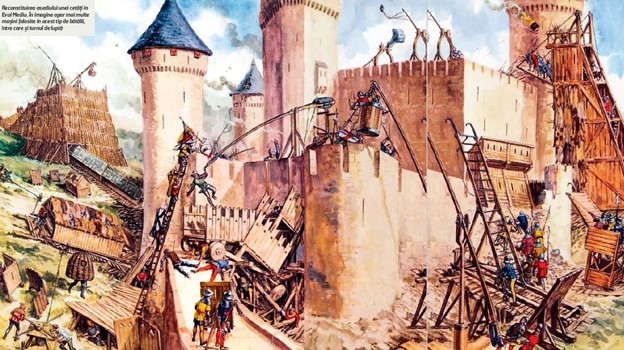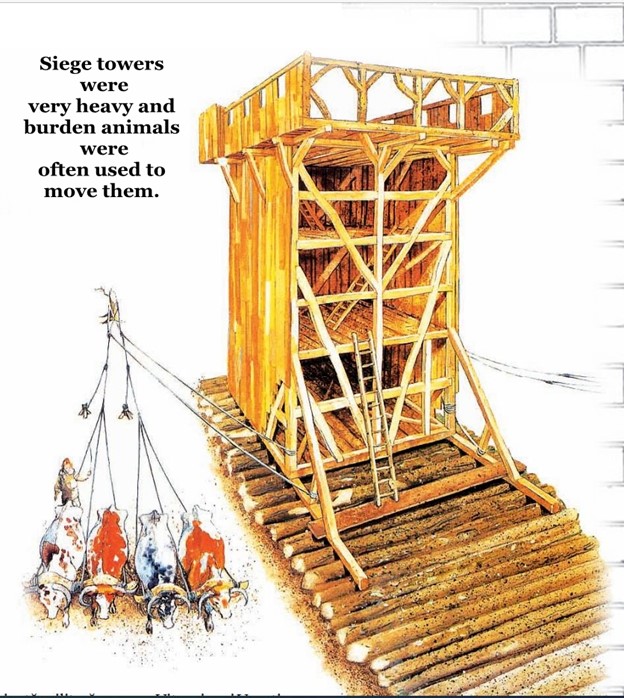Until the advent of firearms, the walls of the fortresses proved to be often impenetrable in the face of assaults, ram blows or the firing of projectiles by ballists and catapults. The besiegers then had one of the most expensive, but also most efficient options: the construction of gigantic siege towers, often mobile, higher than the walls of the besieged cities. These allowed the attackers to safely approach the ramparts and move the battle right on the walls of the opposing fortifications.
In principle, there are five ways to conquer a fortress: 1. crossing over its walls, using stairs or building platforms to the height of the ramparts; 2. destruction of a segment of the walls by projectile shots and ram blows; 3. causing the walls to collapse, by digging underground galleries or demolishing their base; 4. provoking capitulation by encirclement and starvation; 5. the use of tricks and traitors. The simplest method seems to be the first, without requiring special technical knowledge. Instead, it is also the most dangerous, the attackers being permanently exposed to the shooting of the besieged. The appearance of the siege tower is explained precisely by the desire to provide the necessary protection to the troops who aim to reach the walls of the targeted fortress.
In its simplest version, the siege tower is only a wooden parallelepiped, with a height higher than that of the walls (so usually higher than 10 meters), which houses inside warriors arranged on several levels, which communicates through stairs. The tower, placed on wheels, is moved by different methods to near the enemy walls, where the warriors located at the highest level manage to descend the ramparts using a wooden bridge, thus moving the fight inside the fortress. Numerous improvements have been added to this basic idea over time, depending on the needs, resources and inventiveness of the armies that used such a war machine. From the beginning, in Assyria, along with soldiers fighting hand to hand, in the siege towers were housed archers who aimed to eliminate or disturb the defenders on the walls.
Later, next to the archers, at different levels of the towers or even on the roof, battle machines were placed that threw projectiles. Towards the end of the Middle Ages, huge catapults with counterweights (trebuchet) were placed on the upper platforms of the siege towers, while giant rams were mounted on the ground. At other times, as during the siege of Nicaea during the First Crusade, the towers were used to distract the besieged forces in battle on the walls, thus protecting the activity of the saboteurs who acted at the base of the fortifications. Initially dedicated to overcoming the walls above, the siege tower gradually became a perfect shelter for several categories of weapons and a complex fighting machine. Moreover, the siege tower could be used with other categories of forces and other fighting machines. For example, during the siege of Constantinople in 1204, the Venetians built siege towers on the galleys with which they attacked the Byzantines from the sea. On the other hand, towers were often not designed to be moved, but only to gain supremacy in the duel with artillery on enemy walls and to clear enemy ramparts from a distance, allowing rams or assault troops to approach the fortifications safely.
The disadvantages of these war machines
The fact that assault towers often remained motionless indicates one of their great disadvantages: the difficulty of being moved. Sometimes the towers collapsed from the first attempt to move them, as in the case of the siege of the Avars on Thessalonica in 617-618. The traction systems were rudimentary anyway, the towers being moved either by the oxen, vulnerable in front of the defenders’ arrows, or by the effort of hundreds and thousands of soldiers pushing them from inside and behind. Only later, as in the siege of Kenilworth Castle in 1266, the last great siege in the history of England, a complex system of levers and pulleys was used to move the mobile towers. At other times, the ground was either too rugged, too sloping, or too soft for the towers to be used. For example, during the siege of Lisbon in 1147, the tower of the Anglo-Flemish Crusaders sank into the ground on the shore, and the flow of the Atlantic isolated the warriors in the tower from the rest of their comrades for a while. Aware of these limitations, the defenders tried to increase the natural barriers against the assault towers, digging ditches as deep as possible or spilling large amounts of water, mud and even excrement in the way of the war machines. The besiegers had to carry out additional work to ensure a solid and smooth road to the enemy walls: for example, towards the end of the Hundred Years’ War, at the siege of the castle of Bréteuil in Normandy, the French used all the Serbs in the vicinity for a month. to block the defensive ditch on a segment of a few tens of meters, necessary to move a giant siege tower. However, great mastery could be achieved in the construction and maneuvering of siege towers, as in the siege of Jerusalem in the First Crusade, when the Christians moved, on the night of July 9 to 10, 1099, a huge siege tower over a distance of 1000 meters, to a weaker defense sector. The maneuver was decisive for the victory.
Among the shortcomings of the siege towers were the high costs and lack of resources needed to build them. Especially in the East, the lack of wood was a considerable impediment: the Crusaders sometimes brought timber for towers at sea, on the ships of the Venetians or Genoese. On the other hand, wood is a highly flammable material, so some of the most handy weapons for the besieged were firing projectiles or surprise attacks outside the walls to ignite them from the base. The attackers protected the exposed parts of the towers with animal skins soaked in mud and vinegar or, less frequently, with metal plates, which were more effective but more expensive. Against surprise attacks, ditches were dug around the towers, as in the crusading siege of Tire in 1111.
Other drawbacks were the long duration of the construction of a siege tower, as well as the impossibility of keeping this operation hidden for a long time, which allowed the defenders to organize against it. The Avars managed to overcome this obstacle in 626, at the siege of Byzantium, avoiding the construction of towers on the spot by bringing the components, already manufactured, in which to transport, and only their assembly on the spot. Normally, the maneuver was not possible, as the generals did not intend to hinder the movement of such a large number of armies. In addition, the success of battle towers was never certain. In addition to the already mentioned countermeasures, the besieged also had other options to stop the siege towers.
Defenders could opt for the construction of wooden towers on or behind their own walls, higher than those of the attackers. Thick beams were used to block the folding of the wooden bridge of the siege tower, so that the opposing warriors could no longer descend the ramparts. Last but not least, a controlled collapse of the wall, at the right time, could lead to the blockade of the tower without the fortress becoming easily penetrable, the measure being applied by Muslims to the same siege of Tire in 1111. Although some armies had a real preference for building siege towers, such as crusading armies against strong fortresses in the Eastern Mediterranean, often the use of such a fighting machine remained the last option of the commanders. It also relied on the psychological effect of such a construction, which by its size could affect the morale of the defenders to the point that they surrendered.
To increase the frightening effect, but also for protection from projectiles, prisoners were sometimes nailed to the exposed sides of the towers, as did the Syracusans of the tyrant Agathokles at the siege of the Carthaginian city of Utica in 307 BC. or the soldiers of the Roman-German emperor Frederick II at the siege of Brescia in 1328. In conclusion, the balance between the advantages and disadvantages of siege towers depended very much on the particular historical context of the siege. It is no coincidence that the use of siege towers in history has been uneven and different from one geographical area to another and from one era to another. The first mentions of the siege towers come from the Middle Bronze Age, 3500 years ago, in the Middle East, and are due to images on the walls of Egyptian tombs and texts from the archives of Mari (an important city-state located on the river Euphrates). Some historians have argued that the siege towers were also used in the late Bronze Age, citing the famous “Trojan horse” as an example. However, the arguments in favor of identifying the device mentioned by the myths of the Trojan cycle with a siege tower remain deeply speculative.





